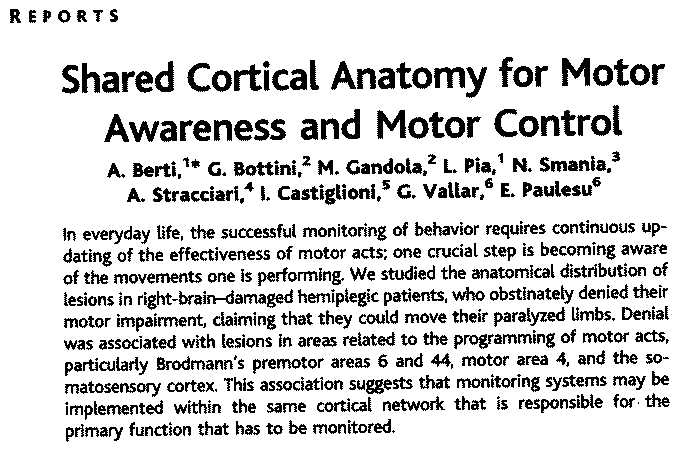[From Bill Powers (2005.07.28.1659 MDT)]
Attached is a scan of the abstract of an article in Science for 15
July 2005, page 488, I would suggest that the patients who
“obstinately” insist that they can move paralyzed limbs are
doing so in the imagination mode and are not able to perceive the actual
state of the limbs. The authors’ conclusion is that “monitoring
systems may be implemented within the same cortical network that is
responsible for the primnary function that has to be
monitored.”
I think that fits our model very well.
Best,
Bill P;

[From Rick Marken (2005.07.29.0815)]
Bill Powers (2005.07.28.1659 MDT) --
Attached is a scan of the abstract of an article in Science for 15 July 2005,
page 488, I would suggest that the patients who "obstinately" insist that they
can move paralyzed limbs are doing so in the imagination mode and are not able
to perceive the actual state of the limbs. The authors' conclusion is that
"monitoring systems may be implemented within the same cortical network that
is responsible for the primnary function that has to be monitored."
I think that fits our model very well.
I would appreciate it of you could give me a little more detailed
explanation of your thinking on this. What I glean from the abstract is that
those who insist that they can move paralyzed limbs have lesions in areas
associated with "motor programming", which I take to mean areas with
descending efferents, which we view as reference signals. So why would this
kind of lesion lead to these people having only an imagination connection in
place? Is the idea that a lesion in this area tends to "re-route" efferent
signals directly back into the "monitoring" (our perceptual) channel? Or is
the imagination connection always there and lesions remove the path through
the lower order reference that typically overrides it?
I agree that the patients who insist they can move paralyzed limbs can be
readily understood to be controlling in imagination mode. But what does the
lesion data have to do with this?
Best regards
Rick
···
--
Richard S. Marken
MindReadings.com
Home: 310 474 0313
Cell: 310 729 1400
--------------------
This email message is for the sole use of the intended recipient(s) and
may contain privileged information. Any unauthorized review, use,
disclosure or distribution is prohibited. If you are not the intended
recipient, please contact the sender by reply email and destroy all copies
of the original message.
[From Bill Powers (2005.07.29.0938 MDT)]
Rick Marken (2005.07.29.0815) --
I would appreciate it of you could give me a little more detailed
explanation of your thinking on this. What I glean from the abstract is that
those who insist that they can move paralyzed limbs have lesions in areas
associated with "motor programming", which I take to mean areas with
descending efferents, which we view as reference signals. So why would this
kind of lesion lead to these people having only an imagination connection in
place? Is the idea that a lesion in this area tends to "re-route" efferent
signals directly back into the "monitoring" (our perceptual) channel? Or is
the imagination connection always there and lesions remove the path through
the lower order reference that typically overrides it?
I suspect the latter, although you could say that if the direct or real-time perceptual path is interrupted, whatever governs the switch produces control by turning on the imagination connection. If this happens at a low level (the motor cortex around the central sulcus is only one synapse removed from the midbrain) the result might well be to hallucinate motor actions instead of producing them. Of course the lesion might be in a place that forces the switch to the imagination mode, with the incoming signals working perfectly well but being ignored. That, too, would result in effective paralysis since no motor output to the muscles would ever be needed. Obviously, the lesion is not in the efferent motor pathways, since that would lead to perception of zero result from willing an action, and the person would see the paralysis immediately. The only way for zero error to be experienced is for the reference signal specifying a perception of motor action to be matched by that perception -- either as sensations from the periphery, or through imagination connections.
To me the main significance of the article is the dawning recognition that the regions of the brain concerned with action also "monitor the results" of the action. From there it's only a small logical step to seeing that action occurs for the purpose of controlling those "monitored results," though it's a giant conceptual leap from where these authors are.
Best,
Bill P.
···
I agree that the patients who insist they can move paralyzed limbs can be
readily understood to be controlling in imagination mode. But what does the
lesion data have to do with this?
Best regards
Rick
--
Richard S. Marken
MindReadings.com
Home: 310 474 0313
Cell: 310 729 1400
--------------------
This email message is for the sole use of the intended recipient(s) and
may contain privileged information. Any unauthorized review, use,
disclosure or distribution is prohibited. If you are not the intended
recipient, please contact the sender by reply email and destroy all copies
of the original message.
